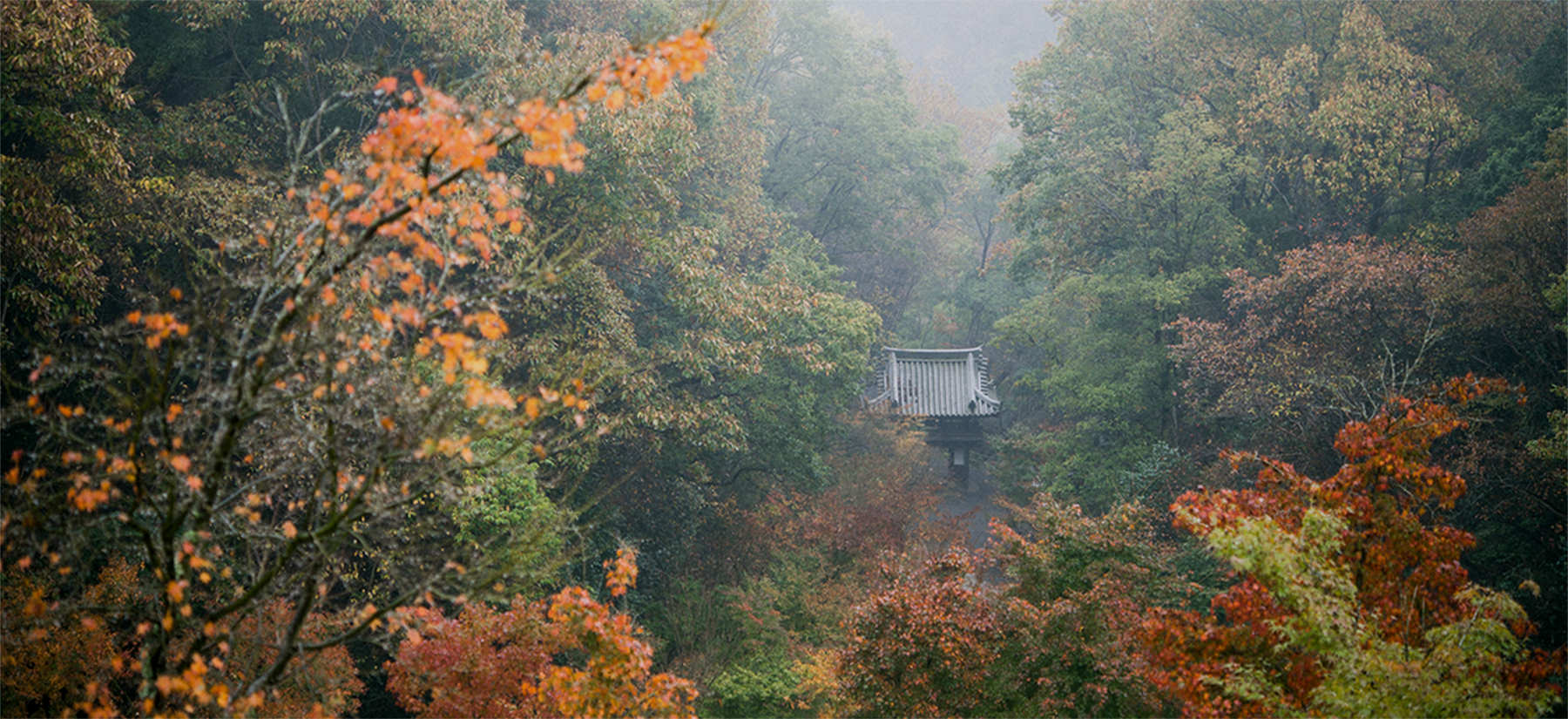EXPLORE ARCHITECTURE
Shoshintei
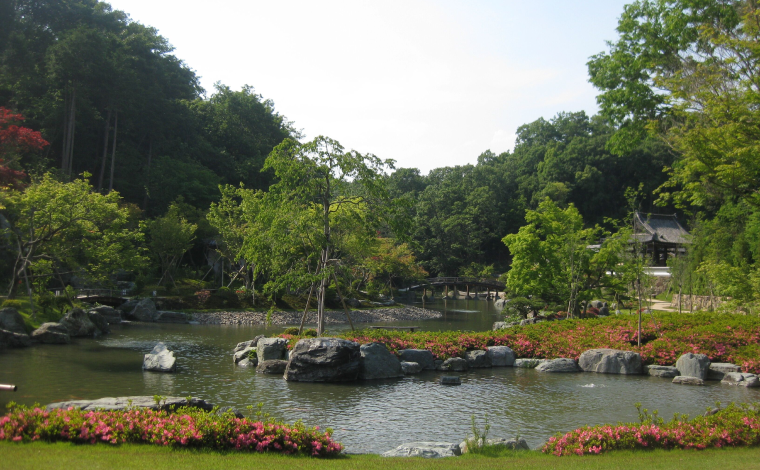
The Shoshintei is a garden created by Shiro Nakane and Yukihiro Nakane. At the center, there is a heart-shaped pond, Shinji-ike. The bamboo fence, which is based on the Koetsuji fence in Takamine, Kyoto, has a unique design with an increased number of Kumiko and woven bamboo spikes, giving it the name "Shinshojigaki".
Somon
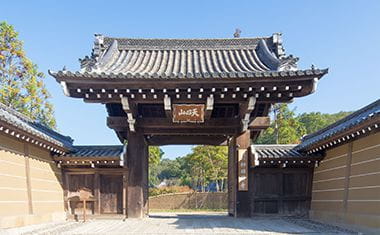
In 1967, the Somon, or main gate, which was built from beech, was relocated to the current site from the old Kayanomiya Palace in Kyoto. Since the late Edo period (1600-1867), the palace had been on the campus of the Kyoto Imperial Palace. In 1965, Hideo Kambara, the founder of Shinshoji, took over ownership of the Kayanomiya Palace. While the palace’s residence was destroyed by fire and does not exist today, the gate has survived here as it was in Kyoto, and greets visitors. The hengaku, or framed calligraphy of the temple’s name, was written by Master Taigan Kobori, the high priest of the Kenninji temple sect.
Shodo
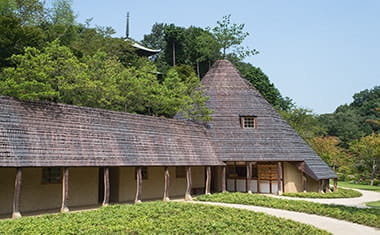
The Shodo, which literally means “Pine Hall,” stands behind the main gate and is the temple’s office building, as well as the visitor information center. The building was designed by renowned architect and architectural historian Terunobu Fujimori, who often uses natural materials and plants in his designs to create buildings that seem to grow from the earth. Pine is a symbolic tree in the Sanyodo (southern mountain region) and Setouchi regions, and the most closely associated with Zen. With the tree as the theme of his design, Fujimori created a building that is integrated with the natural surroundings. He planted a pine tree on top of the slanted roof, which is thatched with hand-bent copper plates and resembles a rocky mountain, and installed pine-tree logs with shaved surfaces as corridor pillars.
Gokando
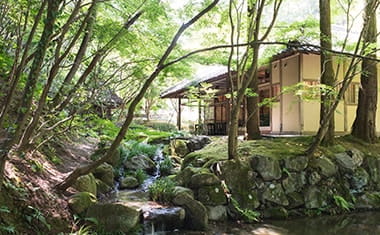
The Kuri, or communal hall and kitchen in the monks’ living quarters, is one of the shichido garan, or the seven essential halls composing the ideal Buddhist temple compound for monks to practice Buddhism. In Zen, all daily-life activities, including having meals and cleaning the space, must be regarded as an opportunity to practice Buddhism. At Gokando, visitors can experience it by eating meals in the same way as monks do in Rinzai-sect Zen monasteries. Udon noodles in hot water, a treat for monks, are served in jihatsu, a set of five bowls, with the long, thick unsui chopsticks used by monks.
Hours open: 11:00-15:00(LO14:30)
Shuroken
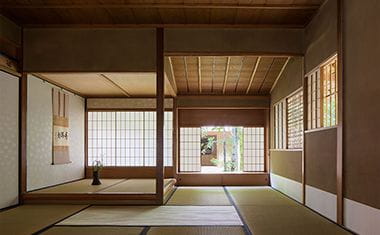
The Shuroken is a tea ceremony room that replicates the Omotesenke school teahouses Zangetsutei, Fushinan and their garden, which were destroyed in the Great Fire of Tenmei in 1788. Famous teahouse specialist Masao Nakamura designed it based on ancient design plans. After the Great Fire the style of Omotesenke buildings and gardens changed, but Fushikisai Horinouchi had recorded the details of Zangetsutei, Fushinan and the garden before the fire. Other documentation about their overall layouts and tea ceremony rooms remain with us today. Nakamura used this surviving information to create Shuroken. Renowned tea gardener Kinsaku Nakane offered his guidance to faithfully recreate the roji, or tea garden, around the building. Visitors can enjoy tea with sweets in the tearoom.
Hours open: 10:00-16:00
Ichiraitei
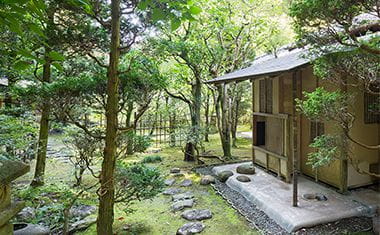
Architect Masao Nakamura designed this tea house, a recreation of the tearoom designed by Sen no Rikyu in his final days in his Juraku Residence in Kyoto at the end of 16th century. While no documents showing the original tearoom remain today, it is inferred that the Sen family’s third tea master, Sotan, created a one-and-a-half tatami mat teahouse that resembles Rikyu’s original tearoom. Although Sotan’s tearoom was destroyed during the days of the family’s fourth master, Koshin, who became the founder of the Omotesenke school, Nakamura created Ichiraitei by referring to the specifications of Sotan’s tearoom as recorded by Koshin.
Gankuin
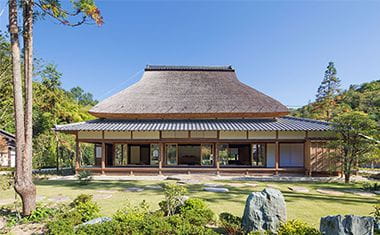
This building was moved to its present location from Eigenji temple, the headquarters of the Rinzai sect's Eigenji school in Shiga Prefecture. In 1377, when Ikkeijun was the temple’s head, Gankuin, Hall of Emptiness, was originally built as Koshinan, a memorial for the first head priest Shoto Kokushi (Zen master Jakushitsu Genko). In 1563, the original building was burned down by soldiers and in 1647 the 81st abbot and Zen master Nyosetsu Mongan reconstructed it as the living quarters for the abbot and a study place for the monks. After its relocation to Shinshoji’s precinct, it has been used as a café, where visitors can enjoy tea, sweets and yudofu (hot tofu).
Kaisando
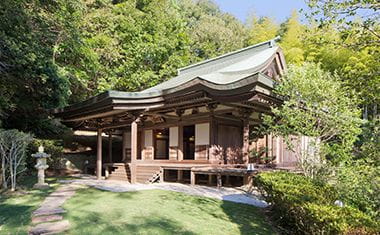
Kaisando is a memorial to the virtue of Shinshoji’s first head monk and Zen master, Ekishu Soshin. He was born in Oita Prefecture in 1896, and entered the Buddhist priesthood at Shozuiji in Katada Town, Shiga Prefecture, at the age of 11, under the supervision of the temple’s master, Otomo Sochu. Ekishu worked hard to enlighten people while serving as the master of Shozuiji temple and Daisenin, and the administrative officer of Daitokuji temple, before becoming the seventh president of the Kenninji sect in 1954. He was invited to be the head priest of Shinshoji temple in 1965. He passed away in 1989 at the age of 92. The building is a replica of Fudodo at Koyasan Kongobuji temple, an architectural masterpiece from the Kamakura period. Worshippers pray to its statue of Ekishu Soshin, created by Murata Toen, a famous potter who worked in Kyoto. The framed calligraphy was written by Zen master Tainen Matsuo, the former president of the Engakuji sect.
Bathhouse
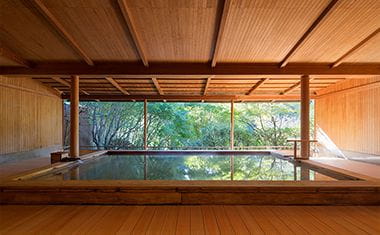
The bathhouse is one of the seven regular buildings (temple gate, lecture hall, Buddha hall, meditation hall, living quarters, lavatory, bath) of a traditional Zen Buddhist temple, and the place where Battabara Bosatsu (Bhadrapala Bodhisattva) is worshipped. In Zen, the study and practice of Buddhism underlies every daily routine. Washing off the dirt both physically and spiritually plays an important role in the daily practice.
Daitetsudo (Private only)
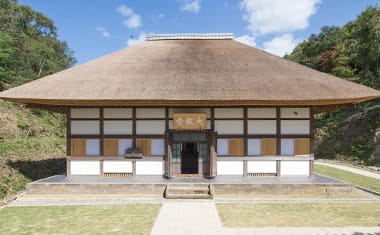
Shinshoji assumed ownership of the 250-year-old building for monks’ Zen practice at Kenchoji temple in Kamakura, Kanagawa Prefecture, and relocated it to today’s location. After relocation, the original thatched roof was restored. The hall is one of the few Zen halls in Japan featuring a plan called shihotan, a unique arrangement of tan spaces, where acolytes practice Zen, placed in four directions. A Zen monk uses only a half-tatami mat space to sit for Zen meditation, and a one-mat space to lie down to sleep at night. Therefore, a practitioner is allowed to use only a one-tatami mat space in the hall.
Tahoto
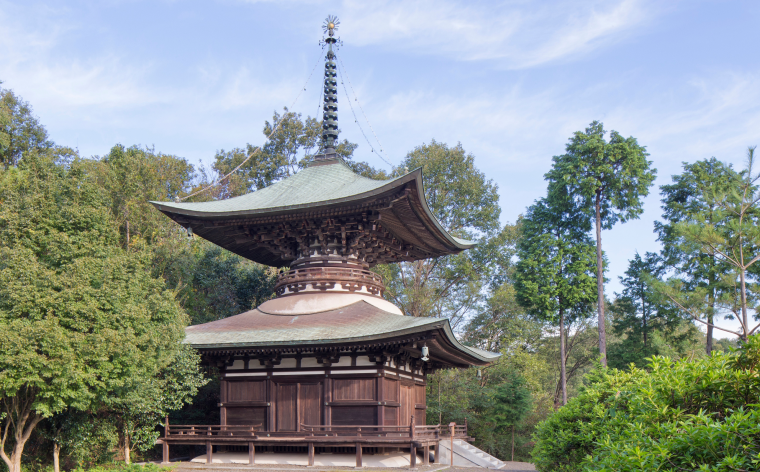
The pagoda imitates the Tahoto from Ishiyamadera in Otsu, Shiga Prefecture, a national treasure from the early Kamakura period. It has a graceful symmetrical design. The wheels on the roof that lead to the heavens were designed specifically for the stupa. The jeweled bells that hang from these wheels continually emit wonderful sounds. The Tahoto is based on the legend that a huge Shippoto (pagoda made of seven treasures, including gold, silver and lapis lazuli) appeared in the sky, when Shakyamuni was explaining the Lotus Sutra. Taho Nyorai (Prabhutaratna), who lives in the eastern world of the so-called "treasure purity", appraised Shakamuni and offered half of his seat to him. Usually Shakyamuni Buddha and Taho Nyorai are worshipped in a Tahoto, but in this pagoda Dainichi Nyorai is enshrined.
Jishoan
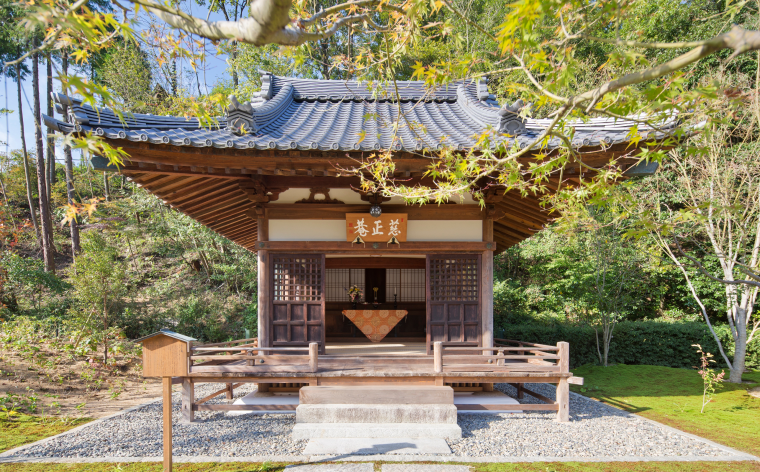
Shinshoji was established in memory of Zen master Mori Daiko Jisho, the first monk of Shinshoji, who was born in the Aichi Prefecture on 22 April 1916. At the age of 11, he was ordained by Takeda Eisen Roshi, the superintendent monk of Kenninji, and sent to the Kenninji monastery in order to learn the monastic life. He entered the sodo (training monastery) of Bairinji after his graduation from college and became the abbot of Reigenin, a subtemple of Kenninji in 1943. On behalf of the founder of Shinshoji, a close friend since the time at the college, he emigrated in 1956 to Paraguay and worked as the head of the Japanese immigrants there. In 1966 he became the first monk of Shinshoji and since then for 41 years he put all his efforts into the edification of the temple congregation and the prosperity of both Shinshoji and Reigenin. In 2007 he became the full-time abbot of Shinshoji, and though he was already over nighty years old, he still exerted himself with teaching and missionary activities. He passed away on 16 May 2013 at the age of 98.
The building was originally the old Hondo of Zorokuan, a temple of the Rinzai sect Eigenji school in Shiga Prefecture. The sitting figure of Daiko Osho in the temple was sculpted by Ezaki Anju.
Eishoin
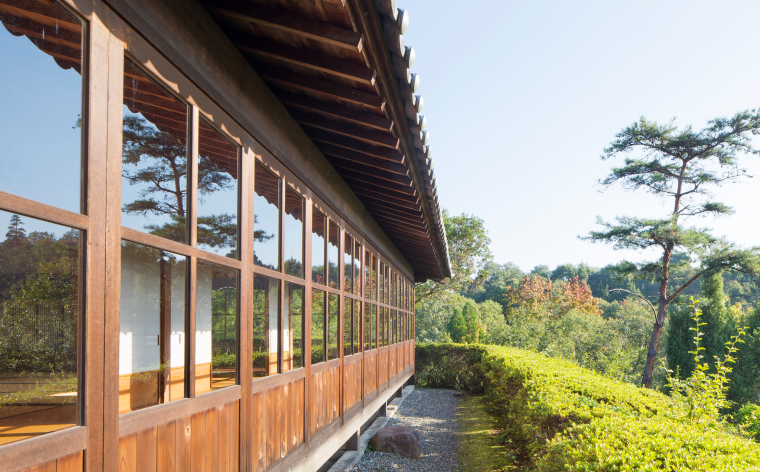
The founding patron created this hall in remembrance of his deceased mother on the occasion of the sixteenth anniversary of her death in 1974. It was modeled after the Study Hall of Jikoin in Yamato koriyama, Nara Prefecture. The temple has a hip and gable roof with pantiled eaves, and it is comprised of an upper, middle, and lower area, each approximately 20 square meters. The upper area features a simple and light design. While it contains flooring and a small study room, the nageshi (decorative wooden beam) has been omitted. Overall the ceilings and lintels are low. It has been designed to encourage peace of mind and relaxation when seated. The view of the garden and mountains from a raised area in the hall is magnificent. The name of the temple comes from the posthumous name of Hideo Kambara's mother.
Shoromon
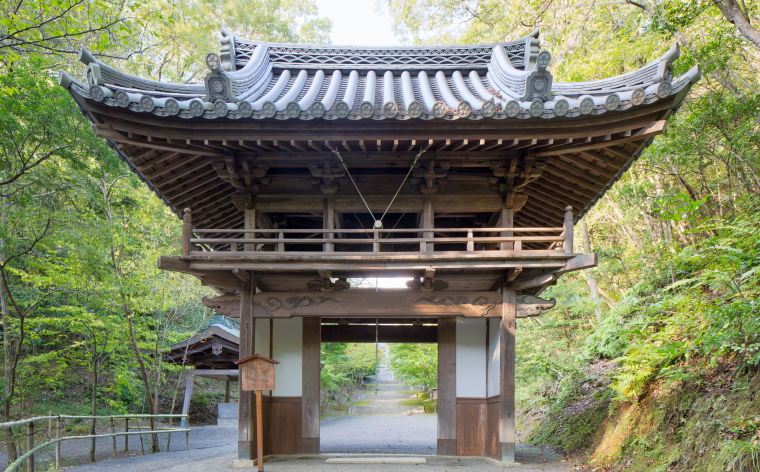
When Shinshoji was originally built in 1965, its main hall was the old Sainenbo. The Main Gate was transferred to its current site and rebuilt as the Bell Tower Gate around 1990. Now standing in front of the long stairs leading to Mumyoin, the sound of the bell on the top brings a peaceful mind to all visitors. Please put your hands in gassho (praying hands) and strike the bell once with sincerity. The Shoromon has no doors which means that all sentient beings can become a Buddhist monk.
Mumyoin
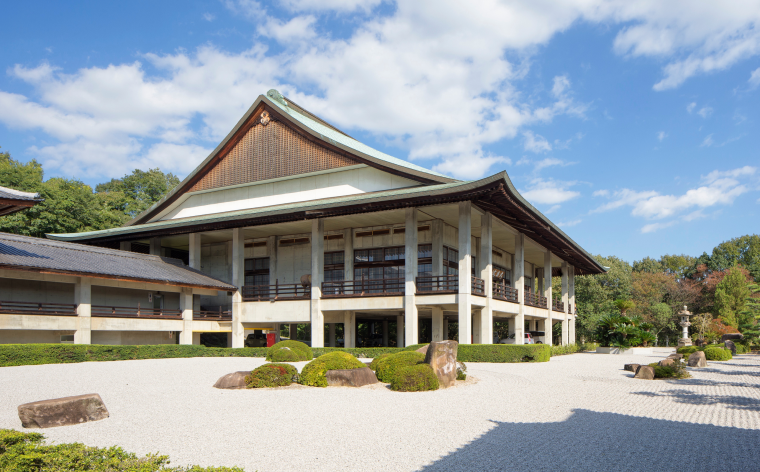
Mumyoin is the Hondo (main hall) of Shinshoji and was opened on 16 February 1977. A statue of Miroku Bosatsu (Maitreya Bodhisattva) is the main figure and was made by Taizo Hamada. The Hondo,main hall has a size of over three hundred tatami mats.
Furthermore, on the far side of the main hall is Meimeiken, a tea room with an innovative design that enables participants to clearly see the tea ceremony action through tiered seating, cameras, and monitors. There is also a Zendo (meditation hall). In the precincts of Mumyoin there are also the Gomado (praying for benefits in the present world), the Hokurido (shrine for a peaceful death) and several others . There is also a karesansui, dry landscape garden, designed by Kinsaku Nakane. Unparalleled in its size, it is comprised of three smaller gardens. If one faces the Mumyoin, the garden on the right is "The Mumyo Garden", in the middle is "The Amidasanzon Garden" and on the left is "The Rakan Garden". The whole grounds can be seen as the consummation of the earnest desire of the patron Hideo Kambara to give worshipers a place to study the self and bring the mind to a peaceful state. Therefore a gravestone was built on a slightly elevated place in front of the Hondo for the memory of the patron, who continually watches over those who visit the temple.
Genan
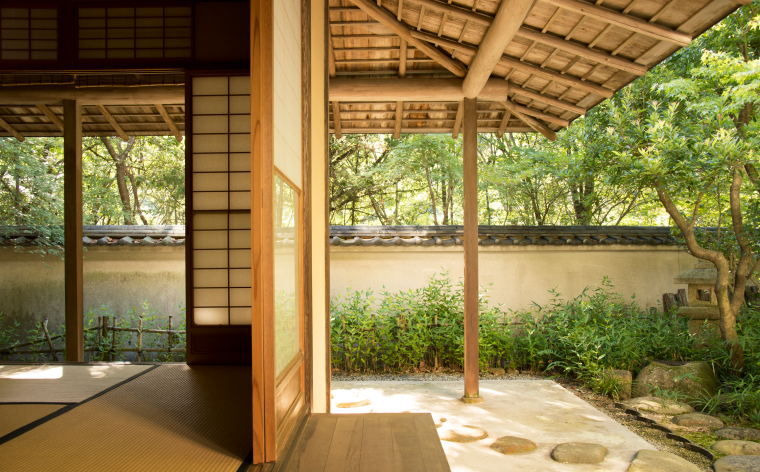
This teahouse is in the precincts of Mumyoin the only building in the sukiya style and has a small room of four and a half tatami mats, a large room of ten and a half tatami mats and a kitchen. Upstairs is an artelier built for the founder Hideo Kambara who loved drawings very much. The garden was designed by Kinsaku Nakane. It has a different flavor than the Japanese dry garden in front of Mumyoin. Between the garden and the building lies a bamboo fence called the Kenninji Fence. The building's walls are covered with Japanese cypress, creating a relaxed wabisabi atmosphere to enjoy tea in peace.
Rokujizo
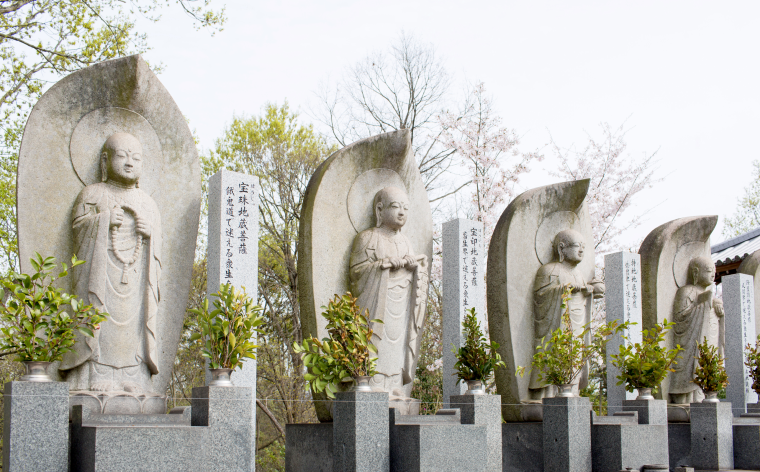
Ten-do (Deva realm or realm of bliss) - Nikko Jizo
Jin-do (Human realm)-- Jogaisho Jizo
Shura-do (Asura realm or realm of demigods)-- Jiji Jizo
Chikusho-do (Animal realm) -- Hoin Jizo
Gaki-do (Preta realm or realm of hungry ghosts)-- Hoju Jizo
Jigoku-do (Naraka realm or hell realm)-- Danda Jizo
Namikirido
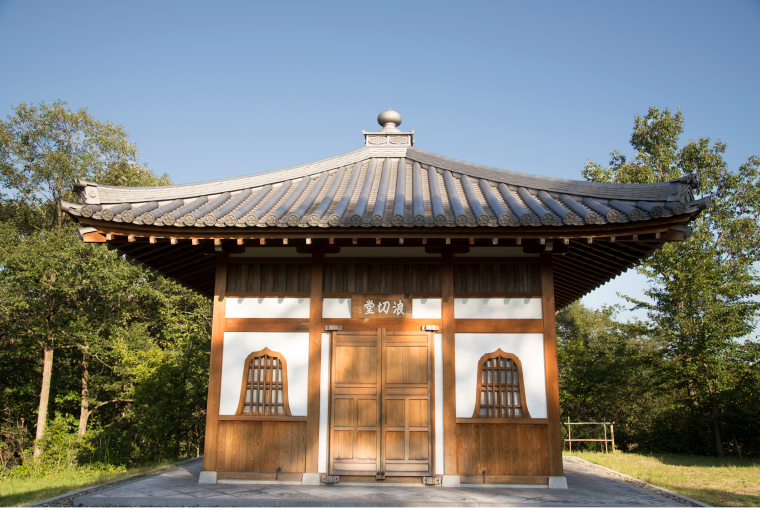
The Gomado was built as a place to pray for safety on land and sea, for good health and worldly profits by burning various offerings in a fire ceremony. The hall is also called Namikirido due to Namikiri Fudomyoo, who is the principal image enshrined in this temple. Kobo Daishi (Kukai) sculpted the figure of Namikiri Fudomyoo for the safety on sea. He bowed three times after every stroke with the blade and it was blessed by his teacher Keika Ajari (Huiguo). When Kukai returned to Japan in October 806, his ship ran into a heavy storm at the Genkai Sea and almost sank. When Fudomyoo (Acala) heard the prayer of Kukai, he appeared, swung the fire releasing vajra sword and calmed the evil winds. He parted the raging waves and guided the ship back to the Hakata Bay. Therefore this deity is called Namikiri ("wave cutting") Fudomyoo.
Hokurido
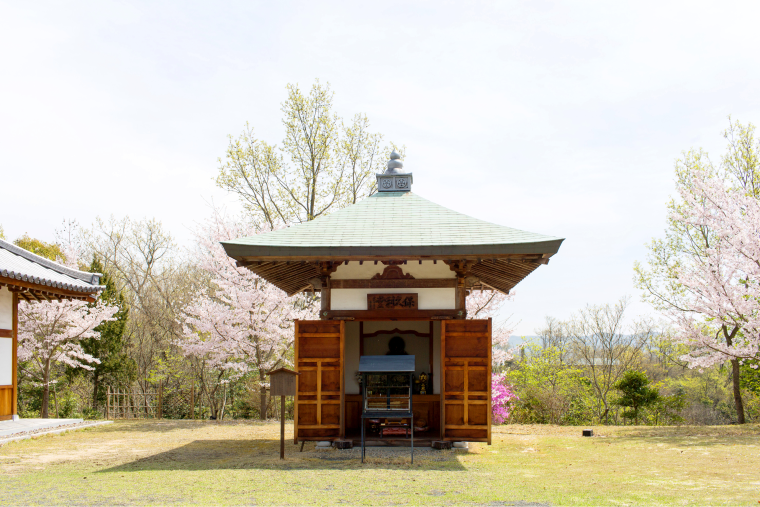
The word "Hokkuri" comes from the Manyo-shu (an anthology of Japanese poems from the eighth century) and means complete, peaceful and tranquil. It is a place not only to pray for a peaceful death without long suffering, but also for a harmonious life in this world, so that under the blissful guidance of Amida Nyorai. Amida Nhyorai (Amitabha) the comfort of paradise can be achieved in the afterworld. The statue of Amida Nyorai in the hall was made by the Taiwanese sculptor Keming Wu.
Chinjyudo
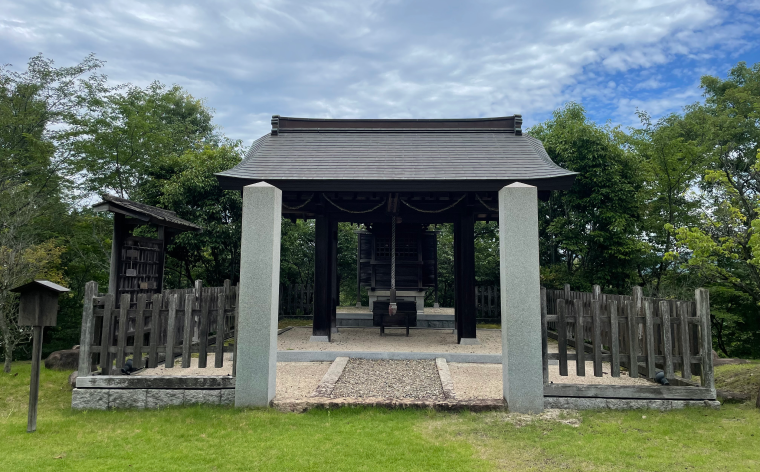
Since old times the believe in the Garanjin as tutelary deities of temple compounds existed in China. Due to the syncretism of Shintoism and Buddhism these deities became also enshrined and worshipped in Japanese temples. Following this tradition the Chinjudo was built to protect the temples and buildings in the precincts from all kinds of disaster. The temple is also called the Tenmangu of Mirokunosato as a reverence for the famous Tenmangu of Dazaifu in Fukuoka Prefecture, where the deity of scholarship is worshipped.
Anrakudo
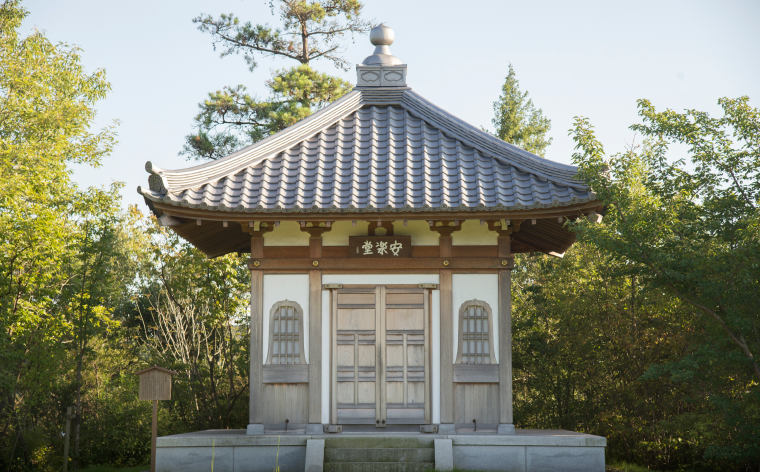
Anrakudo is an ossuary where the ashes of the deceased are put for memorial services. If the ashes are placed at separate locations, the merit can be increased and the deceased will be guided to comfort. The figure of Amida Nyorai (Amitabha) stands in the front while at both sides the statue of Shokannon Bosatsu (Avalokitesvara) is enshrined. On a plate at the wall is a passage from the Bussetsu Amida-kyo (Amitabha Sutra), written by the former superintendent monk of the Eigenji sect, Shinohara Daiyu Roshi: “The people, who live in the land named paradise, have no suffering but all kinds of pleasure. Therefore this land is called paradise”. The name of the temple is taken from this passage.
Kokusaizendojo
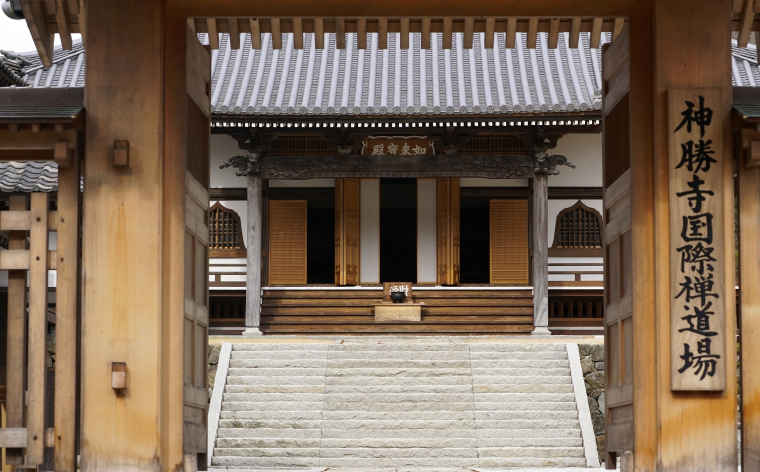
International Zen training hall is a place where both Japanese and foreigners have the chance to deepen their understanding of the self in the way of the Rinzai Zen sect. It is in general not open to the public and consists analog to a traditional monastery of an ensemble of buildings like Hondo (main hall), Zendo (meditation hall), Kaikido (founder's hall), Kuri (living quarters), Shukubo (dorter) etc. The Hondo and the Kuri had been moved from the old Sainenbo and were reconstructed in 1965 for the founding of Shinshoji. The standing figure of Miroku Bosatsu (Maitreya Bodhisattva) as the principal image was sculpted by Ezaki Anju and enshrined in the Hondo. The Zendo was relocated and reconstructed from the sodo (training hall) of Kenchoji in Kamakura, Kanagawa Prefecture. In the back of the temple grounds stands the Kaikido in memory of Hideo Kambara, the donator and founder of Shinshoji.
Hibutsudo
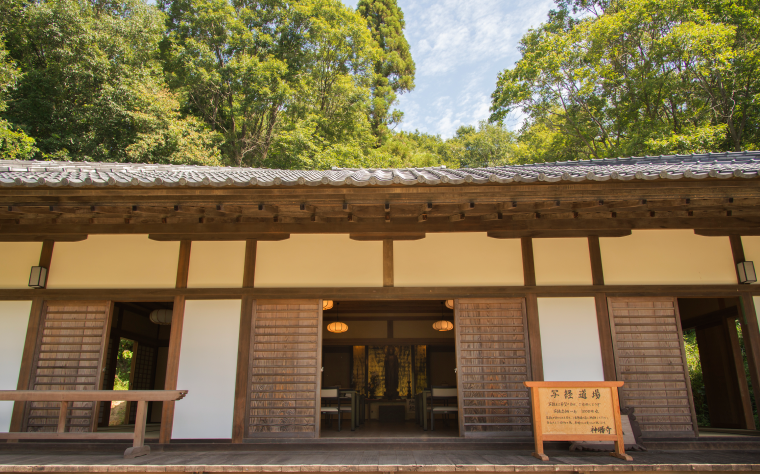
Hibutsudo was initially established as Jibutsudo (Inner Buddha Hall) with a statue of Amida Nyorai (Amitabha Tathagata) as the symbol of faith into the Pure Land.
The standing statue of Amida Tathagata placed in the hall was the personal buddha statue of the founding patron. The quiet and modest style of the hall, designed by the architect Nakamura Masao, reminds people of the smaller sized Togudo of Ginkakuji, where the Jibutsudo of Ashikaga Yoshimasa was set. The founding patron named the building Hibutsudo (Non-Buddha Hall) and wrote the two characters of "Hibutsu" on the plaque by himself.
Shogondo
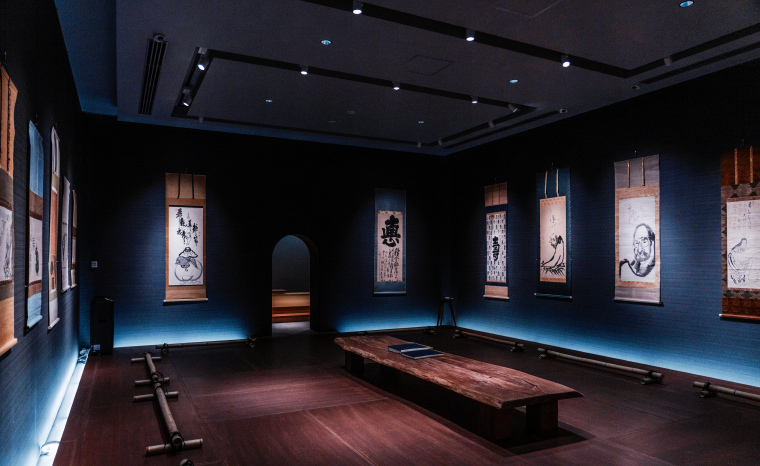
Shogondo is a gallery that exhibits Zen artworks by Hakuin from the temple’s permanent collection. Many Japanese think that the word ‘shogon’ means “to magnificently decorate a temple’s halls, such as the main hall, with statues and objects.” However, according to Nihon Kokugo Daijiten (published by Shogakukan), one of the most authoritative dictionaries of the Japanese language, the correct definition is “to spiritually decorate the body of a person and the place he/she lives with the good and beautiful, such as wisdom and virtue.” Hakuin said, “There is no gorgeous building decorated with gold and silver in a Buddha’s pure land. The land is purified and becomes magnificent by bodhisattvas with aspirations for Buddhahood.”
The Zen paintings and calligraphy by Hakuin exhibited in the Shogondo hall evoke aspirations for Buddhahood in viewers’ minds.
Kohtei
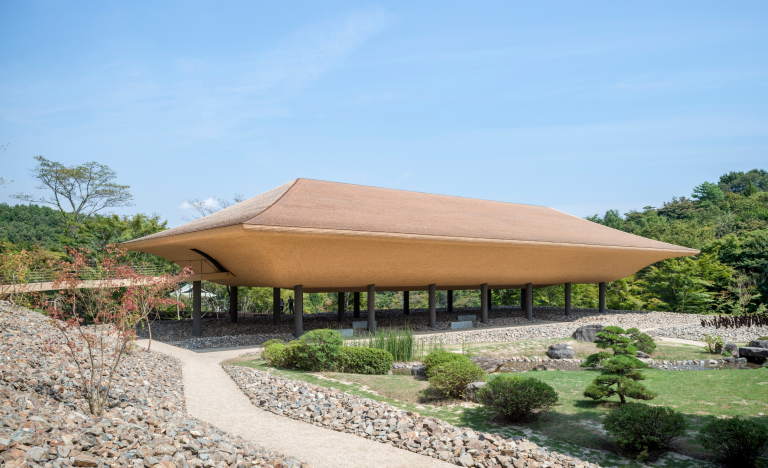
The ship shaped building with traditional kokerabuki wooden shingles, it gives the impression that it is gently floating over the stony landscape. Walking through the ocean of rocks and feeling their materiality, the viewer ascends a slope and enters the pavilion from a small entryway. Inside is darkness, where a quiet ocean lies. The ripples reflect glimmers of light.
